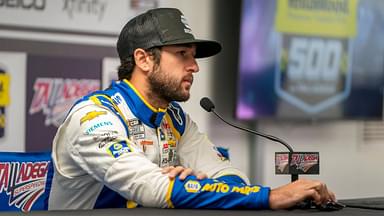After rolling off from P33 at Atlanta, Denny Hamlin had hoped to claw his way back using NASCAR’s revised Damaged Vehicle Policy. Although Hamlin made modest progress — 30th by the end of Stage 1 — his momentum unraveled in the Lap 69 wreck. He ultimately finished 31st overall after exiting the race early in Stage 2.
Advertisement
The incident, triggered by a stack-up and contact between John Hunter Nemechek and Hamlin, swept up nearly two dozen cars. Yet, in Hamlin’s opinion, that wreck may have been a blessing in disguise as it opened the track and transformed the complexion of the race.
On his Actions Detrimental podcast, Hamlin admitted, “I was FOMOed at the end of that race watching it with that much space and the guys creating the runs and having the ability to create the runs and like if they get shuffled to eighth, no problem, they’re back in three laps. I had FOMO there because I was like, damn it, this would be so fun to be a part of this.”
He noted the excitement came from watching single-lane action evolve into dynamic runs, not the typical two-by-two parade where drivers get locked into position. That, Hamlin explained, is what happens when cars are truly on the edge of grip, a trait Atlanta now uniquely demands.
“This is what we aspire Daytona and Talladega to be. It’s where handling actually matters to then start spreading out the field of good-handling cars and bad-handling cars. Give us space to work and work the lines, and then the best car, best driver, will come out on top,” he added.
Hamlin underlined the difference in character between Atlanta and the traditional superspeedways. With Atlanta’s tighter corners and reduced margin for error, drivers walk a fine line, fighting the wheel through every turn.
At Talladega and Daytona, he explained, the broader layout and steep banking offer so much mechanical grip that Cup cars rarely flirt with the edge. The tires, in Hamlin’s words, remain undersaturated, giving drivers more than enough grip to lean into the corners without consequence, largely due to the reduced speeds of today’s cars.
In Atlanta, though, the story flips. Cars move on the edge, skating through corners with minimal margin. Drivers can’t hug the bumper ahead without upsetting the balance. Instead they have to lift, which opens space. One driver backs off, another seizes the opening, and just like that, momentum changes hands.
According to the No. 11 Joe Gibbs Racing driver, the convergence of factors, the car, the track, and the early-race incident, produced the kind of racing at Atlanta this weekend that hits the sweet spot. And while he sat on the sidelines after the crash, Hamlin made no secret of the fact that he felt the sting of missing out on one of the season’s most exciting final stretches.







